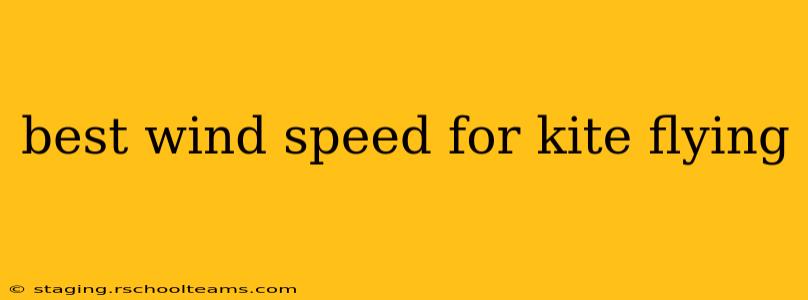Kite flying is a beloved pastime enjoyed by people of all ages. However, getting the perfect flight depends heavily on the wind. Too little wind, and your kite will droop. Too much, and it could be ripped or even dangerous. So, what's the best wind speed for kite flying? The answer isn't a single number, but rather a range, and it depends significantly on the type of kite you're flying.
What is the ideal wind speed for kite flying?
The ideal wind speed generally falls between 8 and 20 miles per hour (mph) or 13 and 32 kilometers per hour (km/h). However, this is a broad guideline. Smaller, lighter kites will fly well in the lower end of this range (closer to 8 mph), while larger, more robust kites need stronger winds (closer to 20 mph). It's crucial to consider the kite's design and your experience level.
What wind speed is too strong for kite flying?
Sustained winds exceeding 25 mph (40 km/h) are generally considered too strong for most kite flying. At these speeds, kites can be difficult to control, and there's a significant risk of damage or injury. Always err on the side of caution and bring your kite down if the wind becomes excessively strong.
What wind speed is too weak for kite flying?
Conversely, winds below 5 mph (8 km/h) are usually too weak to lift most kites. You might get a little movement, but sustained flight is unlikely. Look for a slightly breezier location or wait for the wind to pick up.
What kind of wind is best for kite flying?
Steady, consistent winds are the best for kite flying. Gusts and erratic wind changes can make controlling your kite challenging and potentially dangerous. A gentle breeze that remains relatively constant is ideal for a pleasant and enjoyable flying experience.
How can I measure wind speed for kite flying?
There are several ways to measure wind speed:
- Anemometer: This is the most accurate method. Anemometers are readily available online and at sporting goods stores.
- Wind speed apps: Many smartphone apps use your phone's sensors to estimate wind speed. The accuracy varies depending on the app and your phone's capabilities.
- Observing natural indicators: Look at trees, flags, or water. How much are they moving? A gentle sway suggests light winds, while vigorously bending branches indicate stronger winds.
What type of kite is best for different wind speeds?
Different kite designs are suited to varying wind conditions:
- Light winds (5-10 mph): Single-line kites, small box kites, and delta kites are good choices.
- Moderate winds (10-15 mph): Larger single-line kites, dual-line stunt kites, and parafoils work well.
- Strong winds (15-20 mph): Powerful stunt kites, large parafoils, and inflatable kites are appropriate.
What are the safety precautions for kite flying in strong winds?
Safety should always be your top priority. In strong winds:
- Choose the right kite: Don't attempt to fly a small kite in strong winds.
- Use a strong line: A high-quality line that can withstand the force of the wind is essential.
- Keep a safe distance: Ensure you're far enough away from trees, buildings, and power lines.
- Be aware of your surroundings: Pay attention to other people and objects.
- Consider a kite buddy: Having someone help you manage the kite in strong winds can make a significant difference.
By understanding the relationship between wind speed and kite flying, you can significantly improve your flying experience and ensure a safer and more enjoyable time. Remember to always check the forecast and use your best judgment. Happy flying!
